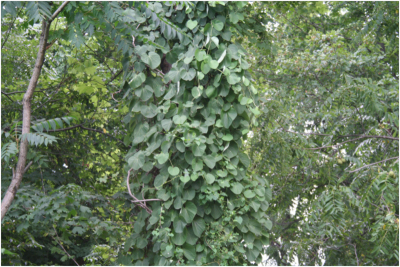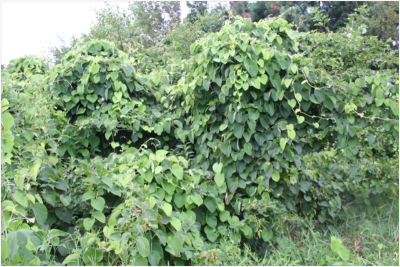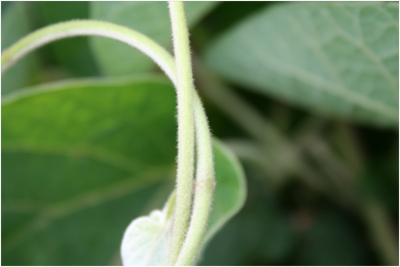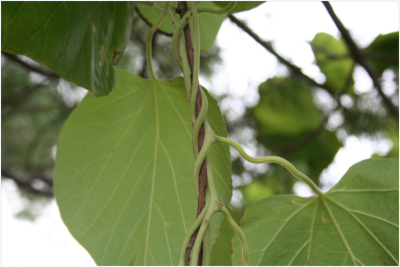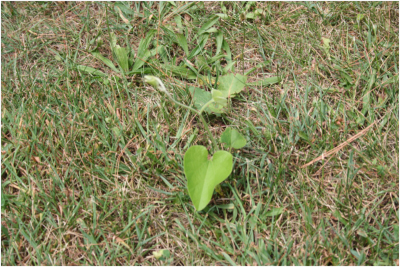Pest & Crop Newsletter, Entomology Extension, Purdue University
- Video for Scouting for Western Bean Cutworm Damage in Northwest Indiana
- Black Light Trap Catch Report
Video for Scouting for Western Bean Cutworm Damage in Mid-August - (Christian Krupke and John Obermeyer)
Click on the above link to watch this video on scouting for western bean cutworm damage in mid-August
![]()
Click here to view the Black Light Trap Catch Report
Figure 1. Woolly dutchman's pipe climbing a tree Figure 2. There are shrubs under there. Woolly dutchman's pipe blanketing trees and shrubs. Figure 3. Woolly dutchman's pipe stems showing soft hairs. Figure 4. Woolly dutchman's pipe winding its way up a shrub stem. Figure 5. Stems will become woody with age. Figure 6. Woolly dutchman's pipe coming up in a lawn.
Woolly Dutchman’s Pipe (Aristolochia tomentosa) – (Glenn Nice and Bill Johnson)
Often I get asked to visit people’s property to identify weeds or plant problems. There is usually a preconceived notion as to what the problem it. This day I made my way up to St. Joseph county to take a look at a possible kudzu patch. At present there are four counties above Indianapolis that kudzu has been confirmed in. Although the two counties surrounding St. Joseph have reported cases, St. Joseph did not. When I arrived, the vine that I saw was definitely acting like kudzu. Like a blanket it was covering the trees underneath (Figures 1 and 2). Like kudzu it had woody stems. The only thing was, it was not kudzu.
What this vine turned out to be was woolly dutchman’s pipe, a native perennial vine that belongs to the birthwort family (Aristolochiaceae), the same family that wild ginger belongs to. Unlike wild ginger, a plant that is a short ground cover, the dutchman’s pipes are twining vines that can grow up to 30 feet long. Woolly dutchman’s pipe has alternate heart-shaped leaves that can be up to 6 inches wide. Each leaf is on a petiole that can be 1 to 3 inches long. As the name ‘woolly’ suggest what makes this specific species unique from dutchman’s pipe is the soft velvety hairs that cover the plant (Figure 3). Stems will wrap around objects that they come in contact with including itself and with age become woody (Figures 4 and 5).
The name ‘Dutchman’s pipe’ most likely came from these plants odd shaped flower. The tube flowers are about 1.5 inches long and have an odd curve to it giving it the appearance of a pipe. The flowers are yellowish-green with a dark purple flower mouth. Seed are found in a cylindrical capsule with rounded edges. Flowering occurs in May to June [1].
Woolly Dutchman’s pipe and Dutchman’s pipe can grow wild, but is often promoted as an ornamental due to its ability to climb a tussle. Its large heart shaped leaves can form a solid looking cover climbing the side of a house or fence. Another reason that this plant is often promoted is that they are native plants to the US. The Indiana Native Plant and Wildlife Society suggests woolly dutchman’s pipe as a source of nectar for adult butterflies [2]. In cases where the plant is planted for this purpose cutting the stems back to the ground surface in the winter is recommended for maintenance.
Not typically considered a problematic plant this is the first time I have had to look into its control. This particular specimen has started to move into a lawn (Figure 6). There is little to no information regarding the control of woolly dutchman’s pipe. I could not find any labels that have woolly dutchman’s pipe on them.
One possible control method could include wiper applications of glyphosate at 1.5% v/v (Roundup) to the large leaves of woolly dutchman’s pipe, being careful not to get the solution on desired shrubs and trees. In areas where the stems are large enough, cut stems and apply a cut stump applications of glyphosate at a 50% to 100% solution. Cut large vines and apply within an hour of cutting and watch for resprouting. When resprouting occurs apply either as a wiper application or isolated foliar applications. Although not on any of the labels and I could not find specific work done, products with triclopyr may be effective in a cut stump or foliar application. Care should be taken that herbicides not labeled for the crop do not come in contact with desired crops and vegetation.
References:
1. Brown, N. and A. Brown. “An Illustrated Flora of The Northern United States and Canada” 1970, first published 1913. Dover Publications, Inc., New York. Vol. 1 p. 646.
2. Anonymous. 2008. Landscaping with native plants to Indiana. Indiana Native Plant and Wildlife Society. <http://www.inpaws.org/Landscaping_1.pdf>.
Soybean Rust Update – (Kiersten Wise)
There have been many questions this week about the movement of soybean rust in southern states and the potential impact of the disease on Indiana soybeans in 2009. Soybean rust was confirmed in one county in southern Arkansas on August 10th and in several counties in Mississippi on August 15th. Weather conditions in the southeastern U.S. have been favorable for rust spore transport and deposition, and we will continue to monitor the northward movement of soybean rust.
Once soybeans are past R5 (beginning seed) and entering R6 (full seed) management of soybean rust is typically not necessary. Many soybeans in Indiana are approaching R5 or beyond, but we will continue to track soybean rust movement and monitor sentinel plots for the disease in Indiana.
Producers are encouraged to track the movement of soybean rust at <http://www.sbrusa.net>. Producers can also subscribe to the Indiana soybean disease update list serve, at <https://lists.purdue.edu/mailman/listinfo/indiana-soybean-update>. This email alert service will provide convenient and timely updates on soybean disease monitoring in Indiana, and also provide information on spray applications if soybean rust reaches Indiana at a critical time during the growing season.
Figure 1. Distribution of soybean rust in the U.S. as of 8/19/09

